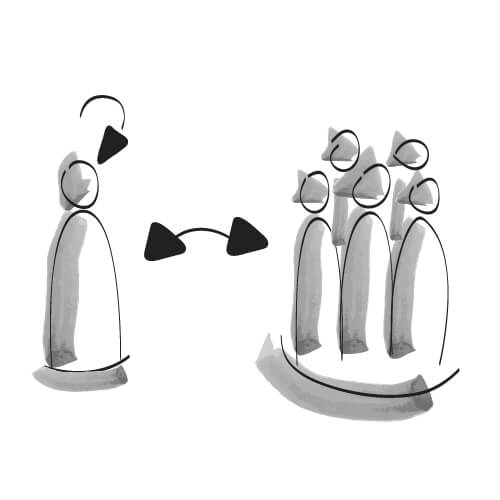You probably made some New Year’s resolutions. Your own health, the health of your family, your colleagues and employees is maybe central in your priorities. What are the key questions that you need to ask yourself and that are an important driver of good health?
Let’s continue our journey (“Leadership: Why don’t we have the impact we would like?”) by shining the spotlight on self-reflection.
When did you last ask yourself questions about yourself?
What do you need to be able to observe yourself in a conscious way?
Self-reflection is the ability to perceive and analyse one’s own behaviour as neutrally as possible. In doing so, you take up a position “standing next to yourself”, the better to observe yourself and others.
By engaging in self-reflection, you adopt a practice leading to a better understanding of yourself and the effect you have on others, and, if necessary, to changes in your behaviour.
This is based on the recognition that we, and we alone, are able to bring about change in ourselves.
Good managers have a good understanding of themselves and the effect they have on others. Self-reflection is natural to them.
As well as considering the nine dimensions of leadership (YouTube video of the LP3 model, 8 minutes) and reflecting on your strengths, points for development and what gives you most pleasure, here are three questions that get right to the heart of self-reflection:
- Do I know my limitations (cognitive, physical, psychological)?
- Do I listen to myself (me and my body)?
- Do I have confidence in myself and do I appreciate myself as I am?
For example, taking question 2 (listening to your body!), if you regularly have a headache in the evening or at the weekend, or you have stomach problems or backache, do you put up with it, take a pain-killer, or reflect on the causes and try to remedy them?
Personally, I find this question difficult to answer. I must admit that, sometimes, I’m not honest with myself. The interesting thing is that OTHERS often notice the signals you overlook. Listen to your partner (husband, wife), your children, your colleagues, your employees. Likewise, YOU will often notice things about the people you rub shoulders with that they themselves fail to notice. Feedback, then, dialogue and listening are important tools in increasing awareness.
This awareness is the first stage in having an influence on health (your health, the health of your nearest and dearest, your colleagues and employees). These three questions are also useful when it comes to preventing burn-out. People who know their limits, listen to themselves, like themselves just as they are will be less at risk of burn-out.
Here are a few things you can do to be more aware, more present to yourself: Mindfulness
Perception of the present moment – the HERE and NOW – increases our capacity for mindfulness. We find ourselves in the present moment, with all our thoughts, feelings and actions. This enables us to shape every moment into something very special. Conscious breathing supports this.
Exercise
Breathe in deeply. As you breathe in, feel how the air is circulating in your body, how your abdominal wall rises, and how your breath travels through your body. Without forcing, let the air you are taking in reach right down to your belly and your pelvis. As you breathe out, feel how the air, warmed by your body, makes its way out again and how your abdominal wall flattens. Allow the ideas that come into your mind to pass in front of you, like clouds in the sky. Be aware of them, but without judging or taking hold of them.
Four-phase breathing (7474):
- Breathe in for a count of seven seconds,
- Hold your lungful of breath for four seconds,
- Breathe out for seven seconds,
- Rest with empty lungs for four seconds, then begin again.
Do this this exercise from time to time, for one or two minutes.
Take five minutes a day to spend time with yourself!
Wishing you fruitful self-reflection!

